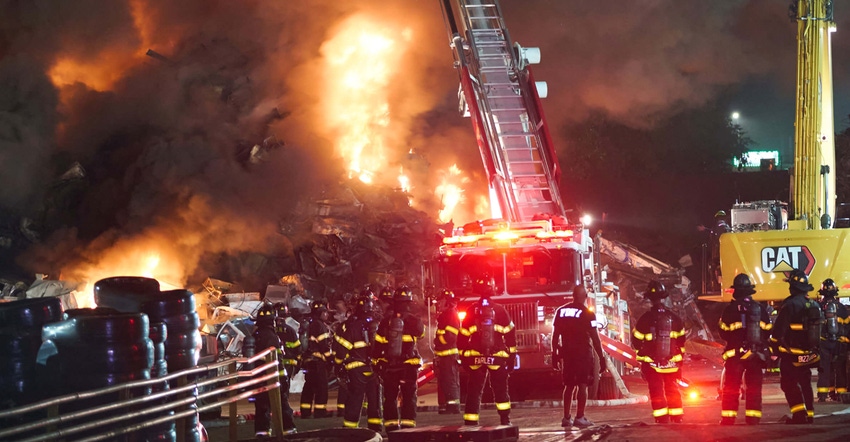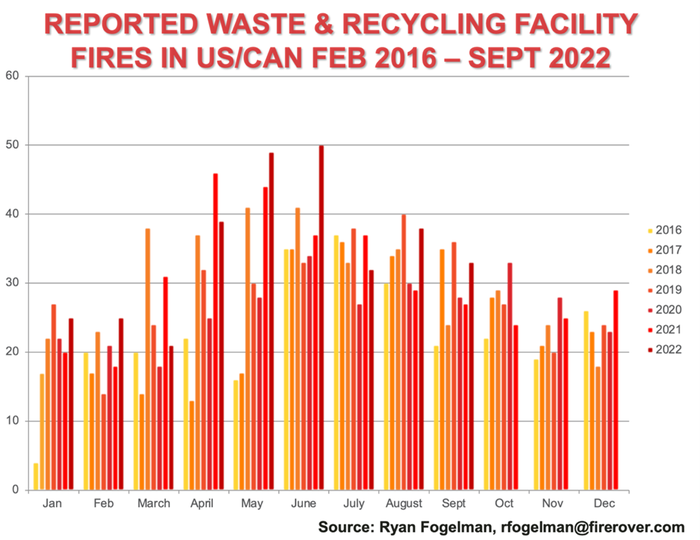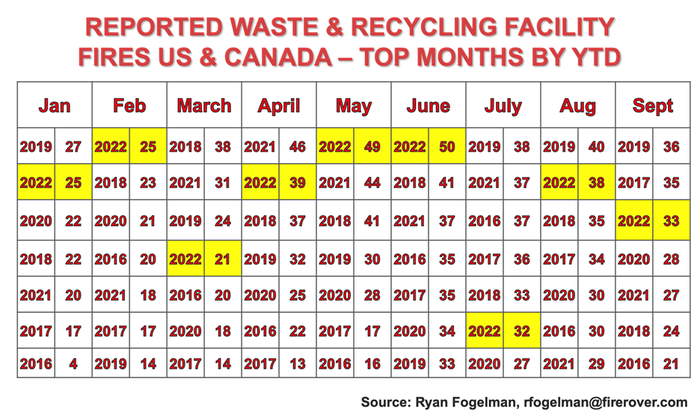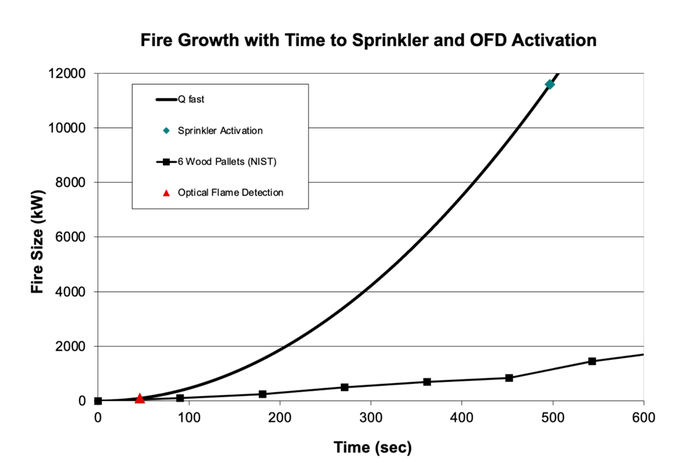Environmentally Responsible Firefighting is a Reality
When it comes to fighting fires, one must not only think about safety but also about being environmentally responsible as we need to work to leave the world in a better place than we found it. In the waste and recycling occupancy, we need to start taking some of the weight off firefighters’ shoulders by doing what we can to minimize fires in our facilities.

When it comes to fighting fires, one must not only think about safety but also about being environmentally responsible as we need to work to leave the world in a better place than we found it. In the waste and recycling occupancy, we need to start taking some of the weight off firefighters’ shoulders by doing what we can to minimize fires in our facilities. With solutions like the Fire Rover, we can do just that.
In this month’s column, I highlight how environmentally responsible firefighting is becoming a reality.
September 2022 Fire Data
This year has been the worst year for fires since I began reporting waste and recycling facility fire incidents in 2016. In September, we experienced 33 publicly reported fire incidents in the U.S. and Canada. Seventeen of these fire incidents occurred at waste, paper and plastic facilities; nine occurred at scrap metal facilities; three occurred at construction and demolition facilities; two occurred at organics facilities; and one occurred at both rubber and hazmat operations. At Fire Rover, we responded to more than 100 fire incidents at our clients’ facilities.

My data only includes the fire incidents that were “reported” by a news outlet, and since I began analyzing this data in 2016, 2022 is turning out to be the worst year for reported fire incidents. Looking at the number of fire incidents using year-to-date (YTD) numbers, 2022’s estimated 416 reported incidents are outpacing all prior years, including last year’s spike and 2018’s lithium-ion battery wave.

As we turn the corner into the final months of the year, the YTD forecast becomes more and more solid, which is not a good thing when the numbers are trending where they are. Remember that this year’s numbers are beating out all prior years after we have had more than six years to educate consumers on the dangers of batteries in our waste stream, developed operational best practices and added technology like our Fire Rover to protect against these fire hazards.

If we compare 2022 to prior years, we see that this year has been the worst or second worst in more than two-thirds of the year. As I showed in last month’s article, we see increased fires in material types across the board. As we finish out the year, I am looking forward to developing the 2022 "Waste & Recycling Facility Fires Annual Report"and taking a deep dive into the numbers to try and comprehend what, if anything, has changed to lead to the spike. Still, my gut tells me that this year's increase has been due to the uptick of lithium-ion batteries in our waste stream and 2022 being one of the hottest, driest years on record.
Use Less Water
In my role with Fire Rover, I have been fortunate to be on the frontline of the next generation of firefighting. The industry has been on a slow-moving trajectory of a “water, water, water” approach to seeking out and utilizing solutions that use less water. Gone are the days when it is OK to deluge 30,000 gallons of foam into a hangar or one million gallons of water to contain a fire that has gotten out of control.
When we first started Fire Rover, a number of folks would question the amount of water we have in our tanks. Our traditional solution uses 1,000 gallons of water and our environmentally friendly encapsulator agent. The reason we use this amount of water is to have enough spray to fight a fire before the authorities (typically dispatched with more than enough time to spare) arrive on the scene and perform final extinguishment activities.
What we have learned is that most of the time our 1,000 gallons are more than enough to deal with the hazards we face in the waste and recycling occupancy. More often than not, we spray for one minute or less using less than 10% of our reserve. In the rare occurrence (less than 20 incidents since 2015) where the fire department or fire brigade needs to come onsite and extinguish, they are showing up to a controlled situation that needs more water to remove hot spots and wet the collateral material.
In a recent FM research report, “Reducing Water Demands Using Innovative Fire Protection Solutions,” smart monitors have demonstrated the ability to reduce the amount of water necessary for un-cartoned unexpanded plastic and cartoned unexpanded plastic fire sources by up to 88%.

Keep in mind these results were evaluated in controlled test environments. In live environments, our Fire Rover solution deploys the benefits outlined by FM’s report and creates the most effective spray patterns in any situation. This has led to successful putouts as well as success while dealing with other factors such as higher piles, human activity onsite, unique hazards and collateral assets, amongst others.

In the same study, FM evaluated the difference in detection times between optical flame detection (OFD) and sprinkler system activation using calculations from the Society of Fire Protection Engineers handbook along with t-squared fire growth rates and provided the sprinkler activation time based on the plume gas temperature and velocity. The calculations resulted in sprinkler activation at a fire size of approximately 11 megawatts and 8 minutes 30 seconds (510 seconds) after ignition. This example used a 40-foot ceiling height and 286 degrees Fahrenheit sprinkler head activation temperature. OFDs are tested to FM 3260 Approval Standard for Radiant Energy-Sensing Fire Detectors for Automatic Fire Alarm Signaling. The standards test the detectors to a 1 ft2 pan fire of heptane, which is approximately 100 to 200 kilowatts in size. At that fire size, the OFD would detect at 45 to 65 seconds. The difference in activation time for the fast growth rate will be more than 7 minutes. With the higher ceilings and slower fire growth rates, the difference in activation time grows significantly.
It’s important to note that when using military-grade thermal cameras as we do in our Fire Rover solution, we can catch fires earlier than the 45 to 65 seconds that an average OFD would take. In addition, we set our temperature gauges earlier than any other solution since we are clearing a ton of false alarms in an effort to catch the fire during its incipient or even pre-incipient stages.
It goes without saying that once you detect, you need to suppress. Check out the video below of one of our thermal installations.
Our team catches the fire quickly and alerts the fire department with a live verification of a real incident. The problem is that once the fire professionals arrive on the scene and assess the situation, the fire has had more than 10 minutes to continue to grow. While the fire professionals work to control the fire and the overall outcome is positive, it is a situation that all parties involved would have preferred to have suppressed much sooner, not to mention the additional water that needed to be used to finally put the fire out.
Conclusion
It seems like 2022 is shaping up to be one of the hottest and driest years on record. Fortunately for the industry, the fall months tend to give us a bit of a reprieve from the record-high numbers we saw during the spring and summer. However, it is no time to let your guard down. The best way to be successful with the problem we are facing is to continue to focus on fire safety every single day. I will be attending both the MRF Operations Forum and the Paper & Plastics Recycling Conference in Chicago later this month if you are interested in connecting.
Ryan Fogelman, JD/MBA, is vice president of strategic partnerships for Fire Rover. He is focused on bringing innovative safety solutions to market, and two of his solutions have won the distinguished Edison Innovation Award for Industrial Safety and Consumer Products. He has been compiling and publishing the “Reported Waste & Recycling Facility Fires In The US/CAN” since February 2016 and the “Waste & Recycling Facility Fires Annual Report.” Fogelman regularly speaks on the topic of the scope of fire problems facing the waste and recycling industries, detection solutions, proper fire planning and early-stage fire risk mitigation. Additionally, Fogelman is on the National Fire Protection Association’s Technical Committee for Hazard Materials. (Connect with Ryan on LinkedIn at https://www.linkedin.com/in/ryanjayfogelman or email at [email protected]
About the Author(s)
You May Also Like




